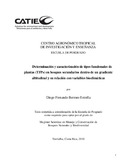| dc.description.abstract | La presente investigación identificó como las especies se agrupan funcionalmente de acuerdo a un conjunto de siete rasgos funcionales clave (Ã rea foliar-AF, Ã rea específica foliar-AFE, Contenido foliar de materia seca-CFMON, Fuerza física de las hojas-FFH, Densidad de madera-DM, Contenido foliar de nitrógeno-N y Contenido foliar de fósforo-P) y su comportamiento frente a la altitud y, de este modo, contribuir el entendimiento de cómo reaccionan ante cambios en un grupo de variables bioclimáticas. Los resultados mostraron que la consistente relación lineal entre estos TFPs, IDF y MPC y variables bioclimáticas, muestra que estas comunidades de plantas se verán más afectadas en el futuro probablemente, por una baja capacidad de tolerar cambios en su ambiente o por una respuesta tardía en términos de cambios evolutivos o adaptaciones fisiológicas, que eventualmente pueden condicionar a un cambio en la capacidad de regeneración, reProducción, supervivencia individual, densidad de las especies y en una reducción en el rango del valor del rasgo y, finalmente, en un descenso en diversidad funcional en estas comunidades de plantas. This research identified how species are grouped by their function according to a set of seven key functional traits (leaf area- FA, specific leaf area- SLA, leaf dry matter content-LDMC, Physical strength leaf-FSL, density Wood-DW, leaf nitrogen content-N, leaf content of phosphorus-P) and their response to altitude and, thus, helping to understand how they react to changes in a group of bioclimatic variables. The results showed that the consistent linear relationship between these PFTs, IDF and CWM and bioclimatic variables, show that these plant communities will probably be mostly affected in the future by a low ability to tolerate changes in their environment or in a delayed response terMON of evolutionary changes or physiological adaptations, which may eventually determine a change in the capacity for regeneration, reproduction, individual survival, density of species and a reduction in the range of the value of the trait and, finally, a decrease in diversity functional in these plan communities. | es_ES |


